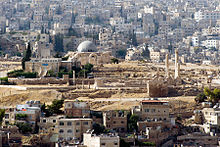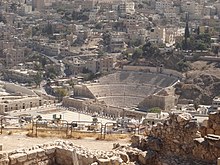| It has been suggested that Umayyad Palace, Temple of Hercules (Amman) and Ayyubid Watchtower (Amman) be merged into this article. (Discuss) Proposed since October 2024. |







31°57′17″N 35°56′03″E / 31.9547°N 35.9343°E / 31.9547; 35.9343 The Amman Citadel (Arabic: جبل القلعة, romanized: Jabal Al-Qal'a) is an archeological site at the center of downtown Amman, the capital of Jordan. The L-shaped hill is one of the seven hills (jebal) that originally made up Amman.
The Citadel has a long history of occupation by many great civilizations. Evidence of inhabitance since the Neolithic period has been found and the hill was fortified during the Bronze Age (1800 BCE). The hill became the capital of the Kingdom of Ammon, sometime after 1200 BCE. It later came under the sway of empires such as the Neo-Assyrian Empire (8th century BCE), Neo-Babylonian Empire (6th century BC), the Ptolemies, the Seleucids (3rd century BCE), Romans (1st century BCE), Byzantines (3rd century CE), and the Umayyads (7th century CE). After the Umayyads, came a period of decline and for much of the time until 1878, the former city became an abandoned pile of ruins only sporadically used by Bedouins and seasonal farmers. Despite this gap, the Citadel of Amman is considered to be among the world's oldest continuously inhabited places.
Most of the structures still visible at the site are from the Roman, Byzantine, and Umayyad periods. The major remains at the site are the Temple of Hercules, a Byzantine church, and the Umayyad Palace. The Jordan Archaeological Museum was built on the hill in 1951. Though the fortification walls enclose the heart of the site, the ancient periods of occupation covered large areas. Historic structures, tombs, arches, walls, and stairs have no modern borders, and therefore there is considerable archaeological potential at this site, as well as in surrounding lands, and throughout Amman. Archaeologists have been working at the site since the 1920s, including Italian, British, French, Spanish, and Jordanian led projects, but a great part of the Citadel remains unexcavated.
History
Excavations have uncovered signs of human occupation from as far back as the Middle Bronze Age (1650–1550 BCE) in the form of a tomb that held pottery and scarab seals. During the Iron Age, the Citadel was the site of the capital of the Ammonites, which was known as "Rabbah" or "Rabbath Ammon". The Amman Citadel Inscription comes from this period, and is considered to be the oldest known inscription in the Ammonite language, written in the Phoenician Alphabet. From the Hellenistic Period, there were not many architectural changes, but pottery provides evidence for their occupation. The site became Roman around 30 BCE, and eventually came under Muslim rule in 661 CE. The Citadel declined in importance under Ayyubid rule in the 13th century, but a watchtower was added to the site during this period.
Main structures
- The Roman Temple of Hercules
- The Umayyad Palace, mosque, and water cistern
- The Byzantine church (ESE of the Umayyad mosque)
- The Ayyubid watchtower
Temple of Hercules
The Temple of Hercules dates to the Roman period in the 2nd century CE.
Umayyad palace and mosque
During the Umayyad period (AD 661–750), a palace structure, known in Arabic as al-Qasr (القصر), was built at the Citadel. The Umayyad Palace was probably used as an administrative building or the residence of an Umayyad official. The palace draws on Byzantine architectural patterns. For example, the entrance hall is built in the shape of a Greek cross. The palace may have been built on top of an existing Byzantine structure in this shape. There is a huge water reservoir dug into the ground adjacent to the palace.
The Amman Citadel Mosque is an example of early mosques that imitated the Persian-style apadana hall, characterized by a "forest of columns"; these mosques are normally found only in Persia and Mesopotamia (Iraq).
Tourism
Starting in 1995–96, the Ministry of Tourism and Antiquities of Jordan in partnership with USAID, AECID and CSIC began several projects to conserve and restore this site to benefit tourists and the local community.
The Amman Citadel is also the site of Jordan Archaeological Museum, which is home to a collection of artifacts from the Citadel and other Jordanian historic sites.
Gallery
References
- ^ Najjar, M. "Amman Citadel Temple of Hercules Excavations Preliminary Report." Syria 70 (1993). pp. 220-225.
- "Citadel, Amman, Jordan". Retrieved 2008-05-31.
- Chatty, Dawn (2010). Displacement and Dispossession in the Modern Middle East. The Contemporary Middle East (Book 5). Cambridge: Cambridge University Press. pp. 116–117. ISBN 9780521817929. Retrieved 25 December 2015.
The first permanent settlement in the southern Syrian provinces, Transjordan, appeared in Amman in 1878. Up until that point, there was no permanent settlement in Amman, the site of the ancient Roman city of Philadelphia. Some of the ancient buildings, such as the amphitheatre, provided occasional temporary shelter for the few farmers from the Ottoman capital of Salt who regularly cultivated patches of land in the area around Amman. This largely abandoned site was important, however, to Bedouin tribes for both its pasture and its good access to water.
- Kassay, Ali (2011). Myriam Ababsa; Rami Farouk Daher (eds.). The Exclusion of Amman from Jordanian National Identity. Cahiers de l'Ifpo Nr. 6. Beirut: Presses de l'Ifpo. pp. 256–271. ISBN 9782351591826. Retrieved 25 December 2015.
The historic development of Amman from a ruin, abandoned for centuries, to the capital city of the Emirate of Transjordan, later the Hashemite Kingdom of Jordan. a combination of natural disasters (believed to be earthquakes) and environmental degradation reduced it to a pile of ruins. The abandonment of Amman was compounded because the basin of its river became infested with malaria, causing the local population to keep at a safe distance. Amman was brought back to life in the late 19th century....
{{cite book}}:|work=ignored (help) - Franciscan fathers (1978). Guide to Jordan. Jerusalem: Franciscan Printing Press. p. 64.
For a thousand years it has no history. In the 15th cent. it is referred to as a pile of ruins. In 1878 it was resettled with Circassians by Sultan Abdul Hamid and took on a new life.
- French, Carole (19 December 2011). Jordan. Bradt Travel Guides. ISBN 9781841623986.
- Bennett, C-M. (1978). "Excavations at the Citadel (El Qal'ah), Amman, Jordan". Levant. 10: 1–9. doi:10.1179/lev.1978.10.1.1.
- ^ Atiat, Taysir M. (2003). "An Egyptianizing Cult at the Citadel Hill (Jabal al-Qal'a) of Amman, Jordan". Levant. 35: 117–122. doi:10.1179/lev.2003.35.1.117. S2CID 162028926.
- Horn, Siegfried H. "The Amman Citadel Inscription." The American Schools of Oriental Research 193 (1969). pp. 2-13.
- Kadhim, M. B., and Y. Rajjal. "Amman" Cities 5.4 (1988). pp. 318-325.
- Milwright, Marcus. "Central and Southern Jordan in the Ayyubid Period: Historical and Archaeological Perspectives." Journal of the Royal Asiatic Society of Great Britain & Ireland 16.1 (2006). pp. 1-27.
- Almagro, Antonio, and Olavarri, Emilio. "A New Umayyad Palace at the Citadel of Amman". Studies in the History and Archaeology of Jordan. Adnan Hadidi, ed. Amman: Department of Antiquities, 1982. pp. 305-321.
- Arce, Ignacio (2008). Luke Lavan; Enrico Zanini; Alexander Sarantis (eds.). Umayyad Building Techniques and the Merging Of Roman-Byzantine and Partho-Sassanian Traditions: Continuity and Change. Late Antique Archaeology, Vol. 4. p. 497. ISBN 978-90-04-16549-6. Retrieved 3 September 2022.
{{cite book}}:|work=ignored (help) (At Brill see here.) - Almagro Gorbea, Antonio (2 April 2024). "Restoration of the Umayyad Alcazar in Amman (Jordan)" (PDF). Loggia (in Spanish). 11: 44–59. doi:10.4995/loggia.2001.5225.
External links
 Media related to Amman Citadel at Wikimedia Commons
Media related to Amman Citadel at Wikimedia Commons


